This post may contain affiliate links, meaning I can earn a small commission from items you purchase (at no cost to you).
Table of Contents
Learning how to meal prep salads is a great way to save time and money. More importantly, it can help you make healthier food choices during a busy week. And let’s be honest: every week is mad busy.
Planning out a week’s worth of salads can feel overwhelming at first, yet it quickly gets easy. Join my free Salad Challenge and get a variety of health salad recipes you can meal prep with. Once you have the recipes and the perfect containers, you can can whip out a week’s worth of salads while watching an episode of Survivor.
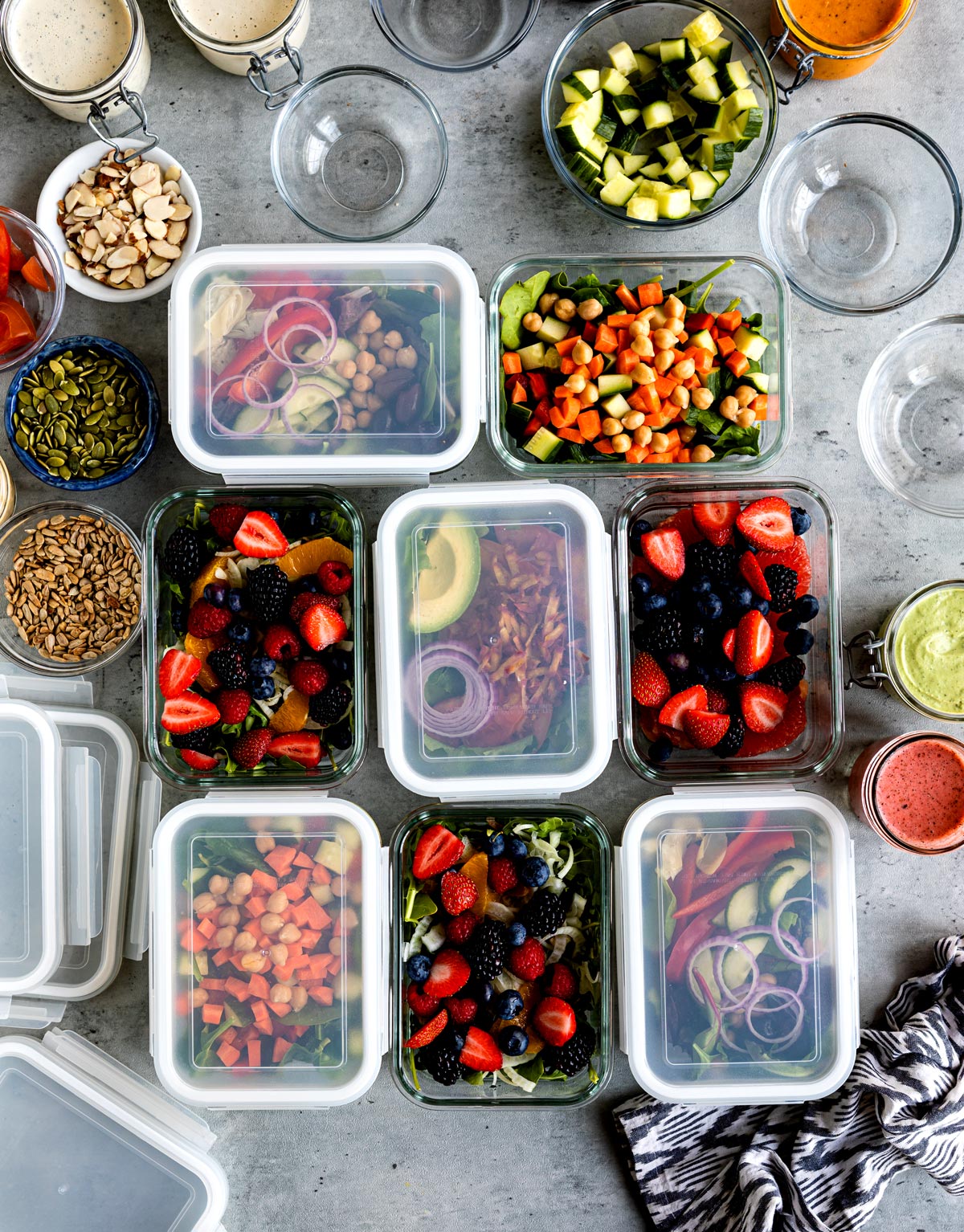
Why Meal Prep Salads
Preparing salad recipes ahead of time, often referred to as “meal prepping,” is a practical and efficient way to eat more fruits and vegetables while saving time, reducing waste, and promoting healthier eating habits.
- Time-saving: Preparing salad in advance saves time during busy weekdays or whenever you need a quick meal. Instead of spending time washing, chopping, and assembling ingredients every day, you can simply grab prepped components from the fridge and assemble your salad in minutes.
- Healthier choices: Having prepped salad ingredients readily available encourages healthier eating habits (especially on busy days). When healthy options are convenient, you’re more likely to choose them over less nutritious alternatives. By prepping salads, you ensure that you have a ready-made option packed with fresh vegetables, fruits, and proteins, making it easier to maintain a balanced diet.
- Reduced food waste: Prepping salads can help minimize food waste by allowing you to use up perishable ingredients before they spoil. By portioning out vegetables, greens, and proteins ahead of time, you’re less likely to end up with forgotten or unused produce in the fridge.
- Saves money: Buying ingredients in bulk and preparing salads at home is more cost-effective than purchasing pre-made salads or dining out regularly. You can also take advantage of seasonal produce or sales at the grocery store, further reducing costs.
- Portion control: By prepping salads in individual servings or containers, you can better manage portion sizes, which can be helpful for weight management or calorie tracking. Having pre-portioned salads on hand can prevent overeating and promote healthier eating habits.
Overall, prepping salad recipes offers a practical and efficient way to incorporate more fruits and vegetables into your diet while saving time, reducing waste, and promoting healthier eating habits.
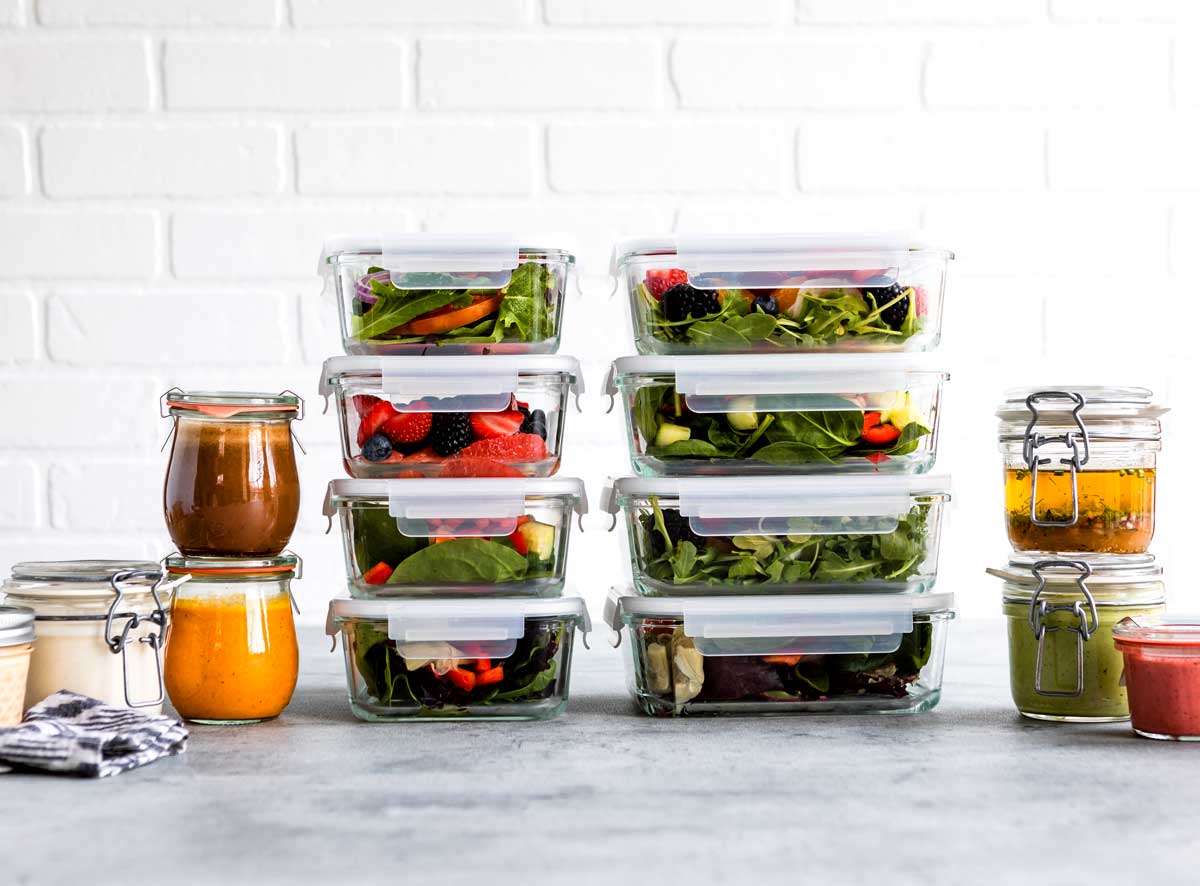
Things to Consider When Meal Prepping Salads
Meal prep salads are good for people who value convenience and efficiency more than variety. With meal prepping you generally eat the same thing for a few days in a row. If you don’t like leftovers or get bored with food easily, meal prepping is prob not gonna be your thing. If having control over what you eat, or maximizing your time or budget is more valuable to you than eating something different every single day, read on.
- How many people do I need to prep for? Is it just you eating salads? Maybe your spouse or sister or son wants to do it, too? It’s important to keep in mind how many people will be eating the salads so when you prep you have enough stuff.
- Will I be eating these at work, home or on the road? Depending on when you’ll be eating the salads will dictate which style of containers you use for salad prep.
- What recipes do I want to eat? Do you want to repeat salads, use the same dressing each day, have a variety of toppings, etc.
- Are there ingredients that will go bad faster, like strawberries? If so, make sure to eat those salads earlier in the week.
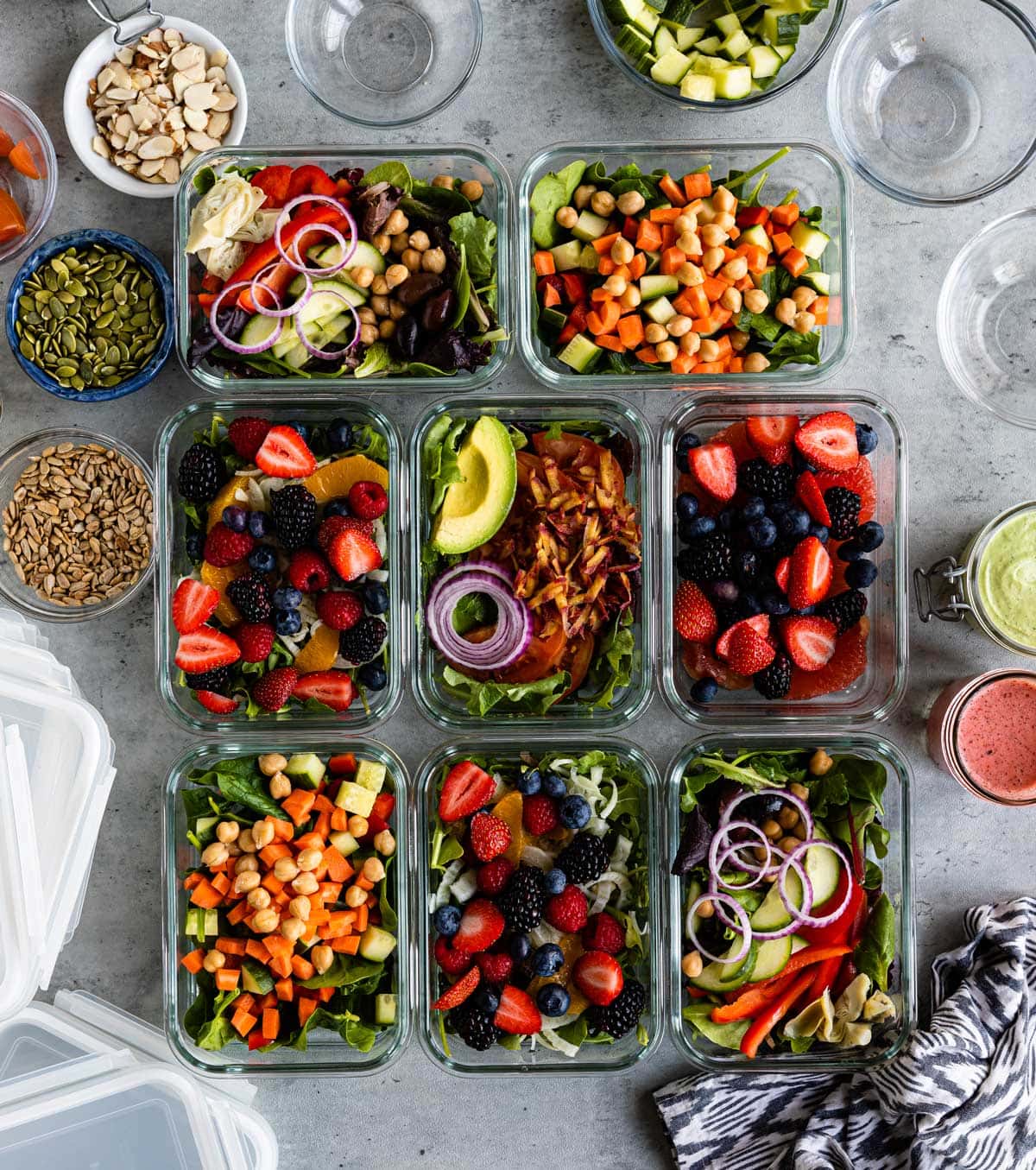
How Long Will Meal Prep Salads Stay “Good”?
Leafy greens are quite delicate plants. I can’t tell you how many times I’ve opened a bag of spinach and gagged once the rotten air hit my nose. It can go from “great” to “gross” overnight. Yet leafy greens are the star of the plant-based world and deserve a second change (or third)— trust me! Most salads will last 3-5 days in the fridge.
- Use freshly bought produce: the fresher the produce, the longer the salad meal prep will last in the fridge.
- Store in proper containers: you’ll want air-tight containers to protect the salad
- Eat the delicate salads first: Eat the salads that are using delicate ingredients like berries and spinach. Kale and apples are more durable and can be pushed to the end of the week.
- Don’t add dressing until ready to eat: Leave off the toppings and dresing until right before you eat it. This helps the leafy greens and fruit stay nice longer.
How to Keep Salad Greens Fresh
Immediately open the greens and discard out any yellow or discolored leaves. Place a clean paper towel in with the remaining greens and close. Store in the fridge until ready to use. The paper towel helps absorb some of the water and prevent them from spoiling so quickly.
You can also use 5-star Produce Food Storage container with 11,900+ reviews keeps lettuce fresh with a vent, crisp tray and filter. You can also try half gallon Stasher Silicone Bags to store salad.
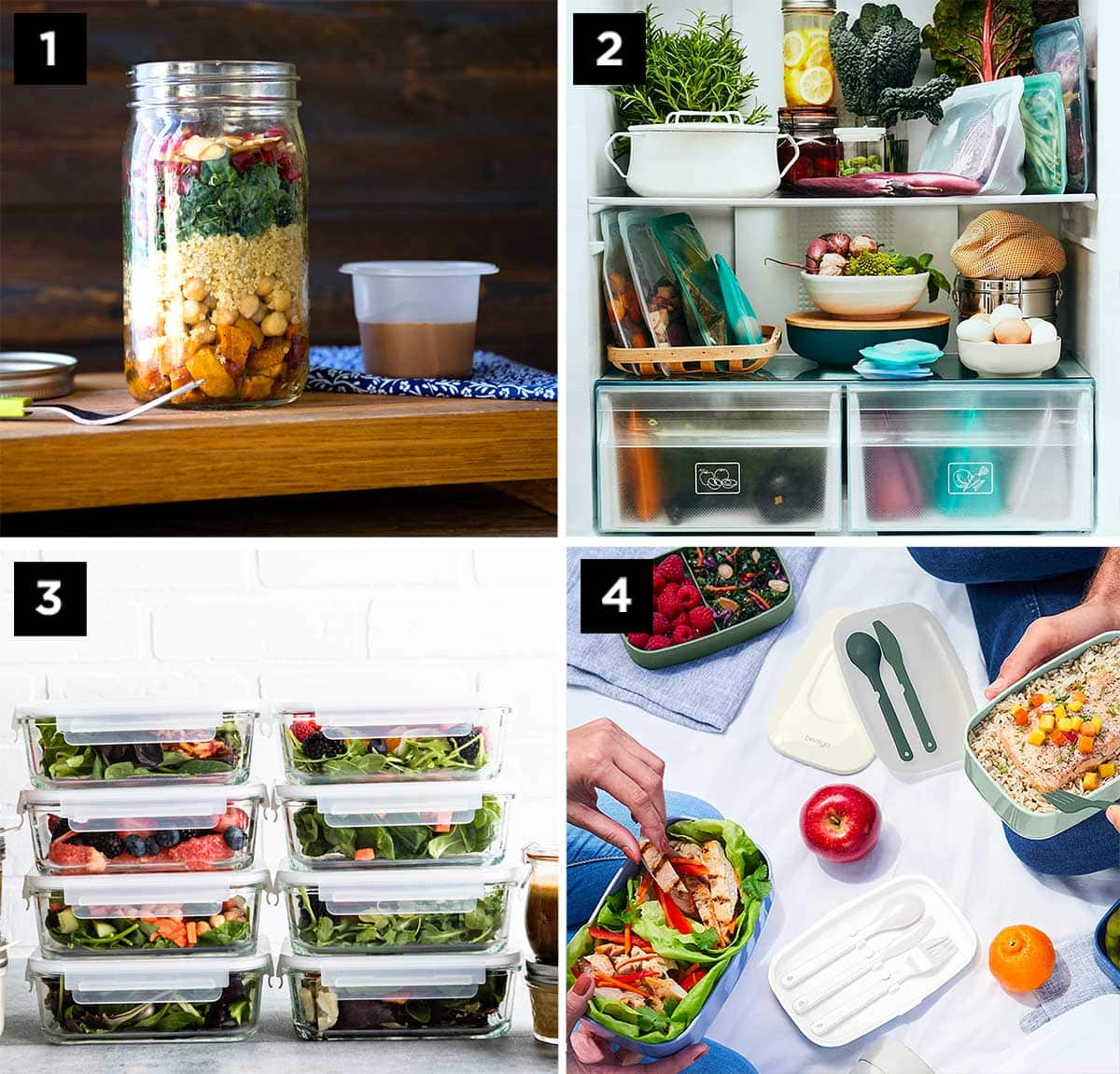
Best Meal Prep Salad Containers
I have an embarrassing collection of salad prep containers. I’m a sucker for new styles and can’t pass up anything in my favorite colors (army green and navy blue). The key is that they are air-tight, stack nicely and look cute. Here’s a few options that have worked well for me:
- Quart Mason Jars: I usually store soups, berries and smoothies in these quart size containers, but they do work really well for chopped salads too. They store nicely in the fridge. I drizzle the dressing on top and shake until it’s coated every piece of lettuce. Works best if you’re eating at home since you’ll want to serve on a plate.
- Stasher Bags: These are definitely the most space-conscious option. I love how they can stack or sit upright in the fridge. These work best if you’re eating salads at home since you’ll have to transfer to a plate. As much as I love the concept, cleaning these bags is never fun.
- Glasslock Containers: These are the most versatile containers I’ve ever bought. I love that they are glass and can go in my toaster over or freezer. They work great for salads and stack nicely in the fridge.
- Bento Boxes: These reusable all in one stackable containers are aesthetically pleasing and smart design. Great for bringing salads to work —I love the built in fork. I love shaking my salad together with the dressing when using a bento box. If you need something on the go, check out these light weight versions.
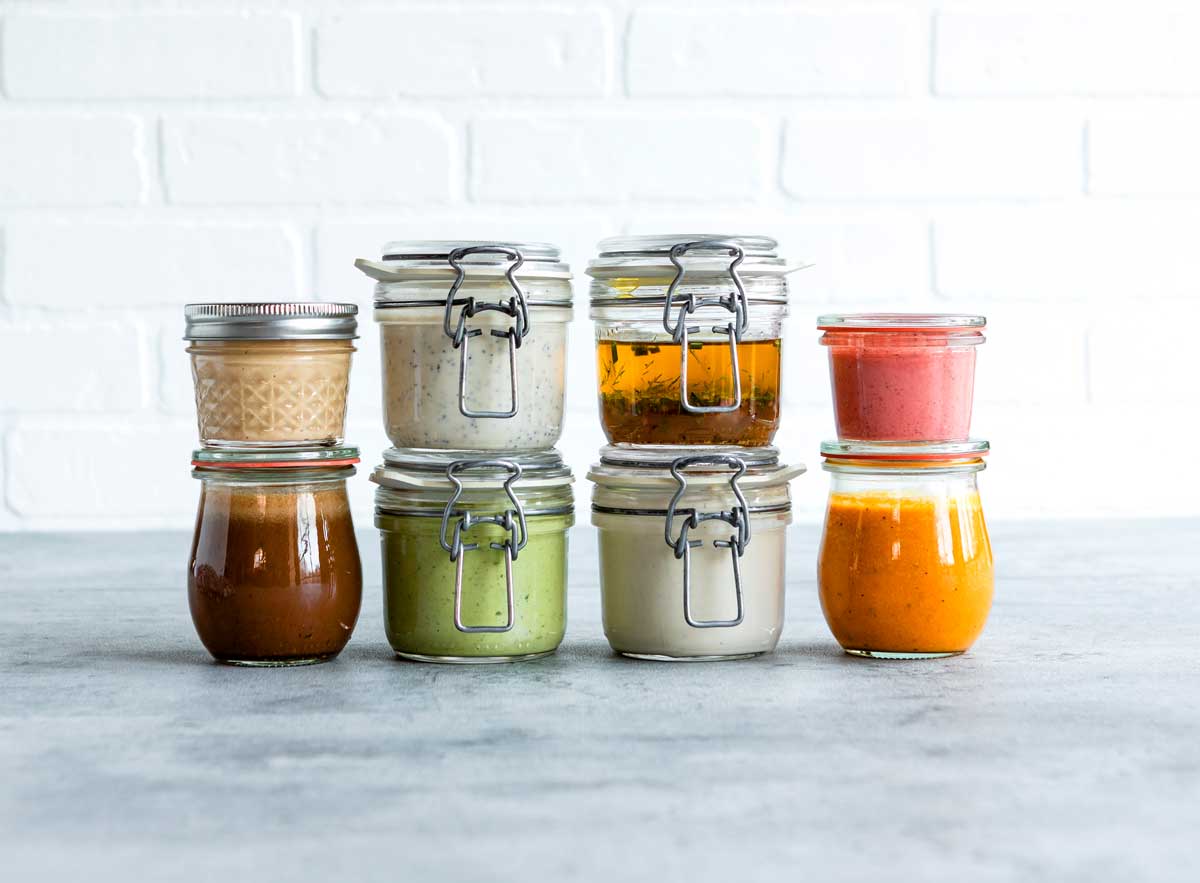
Best Salad Dressing Containers
The key to a good salad is the dressing. I love making my own dressing because the flavor is much more robust and the nutrients are much higher too. Plus, make it once and you can use for a week of salads if you have a recipe you love. Below are some dressing containers that I use when I meal prep salads:
- 4oz mason jars: affordable and a great size for dressing. If using vinegar in your dressing, the band can rust. I also use these containers to store my supply of homemade deodorant.
- Weck mini mold jars: these elegant petite jars always remind me of the French countryside. Not quite sure why, but I’m thinking it’s just the craftmanship and artisan vibe. Turns out they are made in Germany, but I still pretend I’m in France.
- Hinge-top glass jars: These 7oz containers seal well and store just the right amount of dressing get you through a few meals. I love how easy they are to stack and seal.
How to Store Salad Dressing
When storing salad dressing, I definitely suggest keeping it in a clear container so you can easily identity each dressing. Salad dressing can be stored in the door of the fridge, stacked on a shelf or even inside the meal prep salad container.
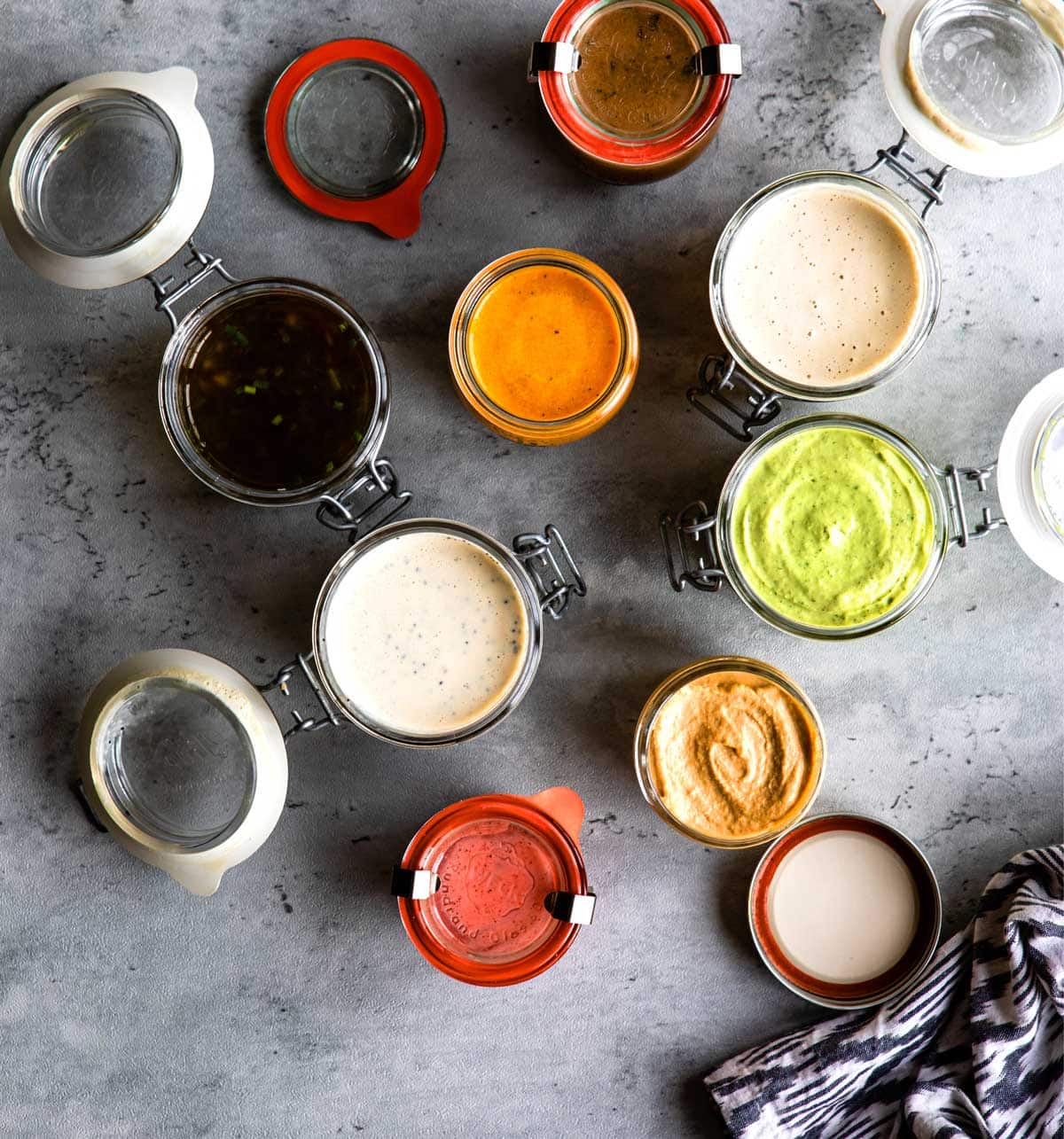
Meal Prep Salads tip
Start with a base of greens, then add any vegetables, fruit and beans. In a separate air-tight container, store any dry goods (ex: pepitas, sunflowers seeds, vegan parmesan cheese, dried fruit). Keep your salad dressing separate until you’re ready to eat to prevent a soggy mess.
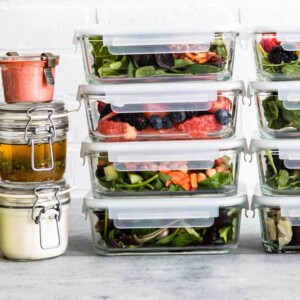
How to Meal Prep Salads
Ingredients
- 4 cup mixed greens
- 1 cup cucumber sliced
- 1 apple green
- 1 avocado
- ¼ cup sliced almonds
Strawberry Dressing
- 1 cup strawberries
- 2 tbsp fresh basil
- 2 tbsp extra-virgin olive oil
- 1 tbsp lemon juiced
- 2 tsp pure maple syrup
- ¼ tsp sea salt, unrefined
- ¼ tsp black pepper, ground ground
Instructions
- Puree the dressing ingredients in a blender or food processor. Store in airtight container.
- Divide salad ingredients between two salad prep containers.
- Store in fridge or lunch box w/ ice pack until ready to eat.
Helpful Tools
Notes
- Mix n’ match the salads and dressing recipes to fit your preferences.
- Use what you have on hand! Tossing in an extra pepper, olives and more can jazz up your salad + leave you without spoiled ingredients.
- Use seasonal ingredients: find out what is fresh right now in your area as it will be the most nutrient dense.

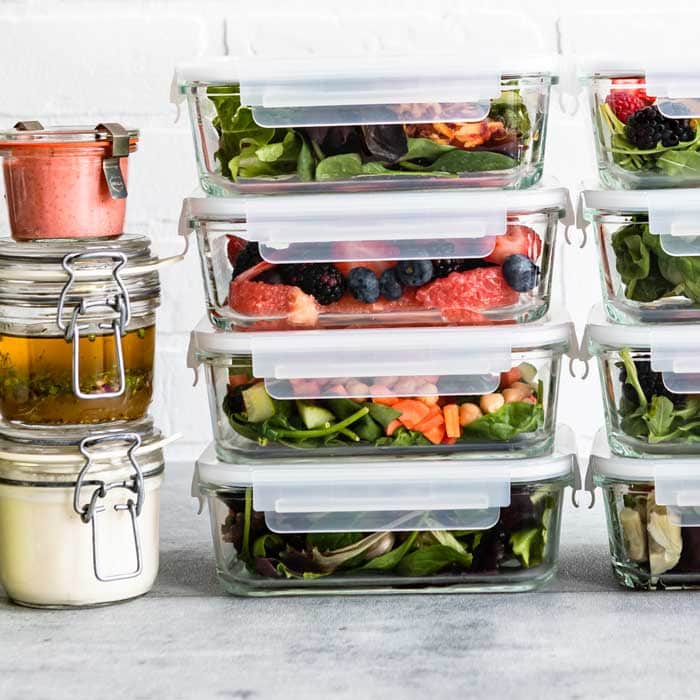
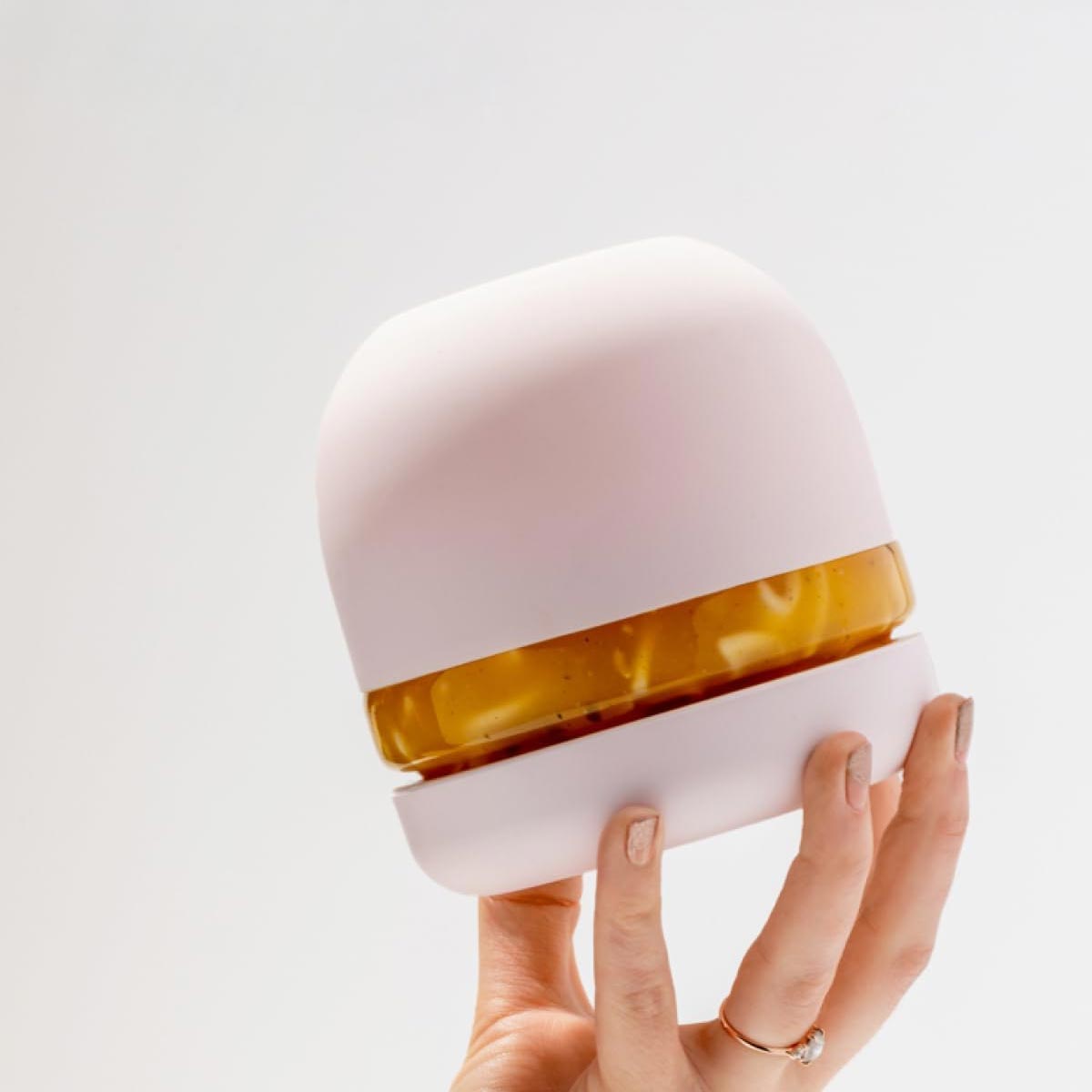
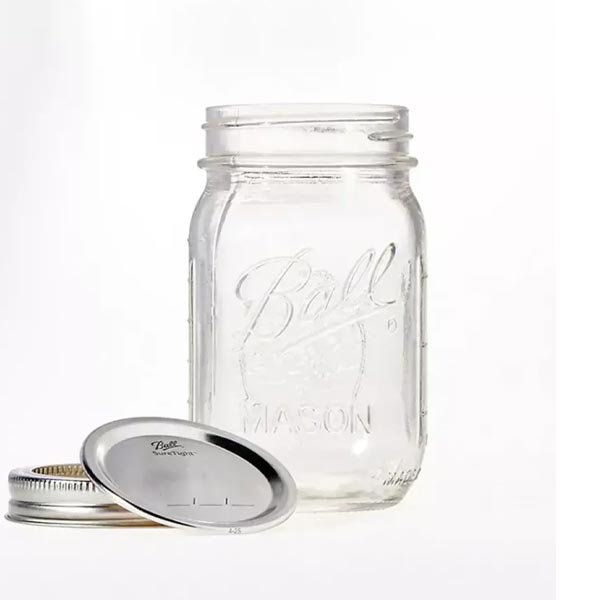
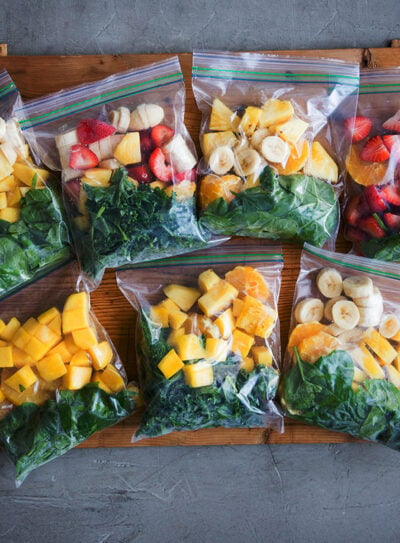
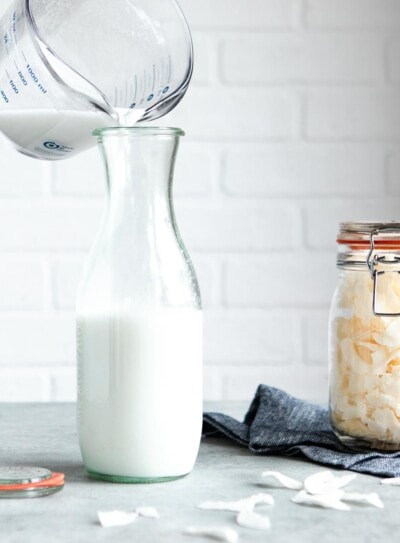
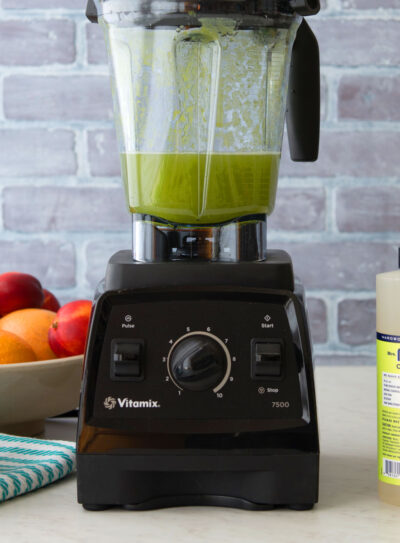
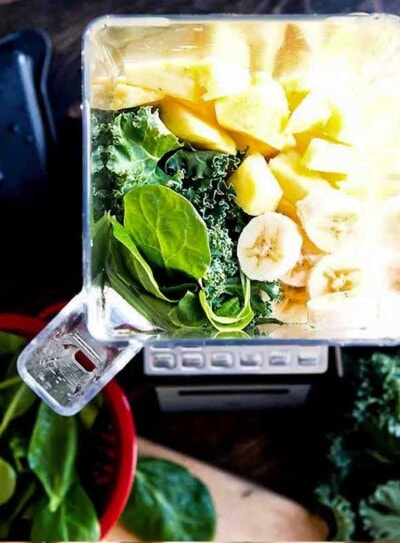
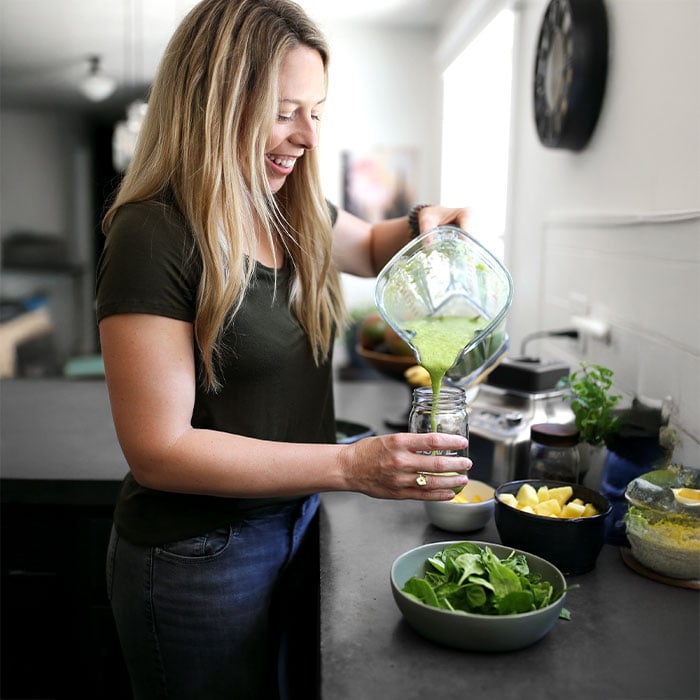









I. was always active, ate clean.because I liked it. Now,fter multiple life challenging experienc, I need guidance ,incentive, am 75 years old.Am seeing a doctor,in the meantime, I will get my kitchen ready, utilizing the free smoothie and salad recipes.
I hope you love them, Annette!
I’m going to start with the salad suggestions I received via email. This is so helpful because I was getting tired of the salads I’ve been making (sorry couldn’t think outside the box). I’ve printed them for the two week suggestion and will try, and so happy that I can make my own dressing, I cringed at the ingredients in the store bought dressings.
I’ll come back to after the two weeks, I really appreciate this list!
Carmen
We’re so glad you’re using it. How did you like the homemade dressings?
I will never go back to buying this again!
So easy when you break it down! Thank you for inspiring me!
How do you keep the apple and avocado slices from turning brown?
Squeeze a little lemon juice on them. You can always save these ingredients to prepare just before eating, too.
This the type of inspiration I needed to enjoy salads again. The detail is easy to follow. This is life-changing and I know I won’t b3 bored. Thank you
#10daySaladChallenge 2022
I’m so glad you’re feeling inspired to enjoy salads again!
I recently discovered the glass containers. My favorite is a divided glass container. I can separate things like cucumbers from the lettuce. I love it. I use the small mason jars for my dressing. They may be a tad big but they are glass and the only thing I can find that is small. I am so excited to try some new dressings. great to mix up my amazing salad with a different topping. Thanks Jen and the Rawkstart team.
Can’t to hear what you think about the new dressings! Sometimes what I do is reuse a glass spice container. They work really well for dressings.
I appreciate all the photos that show how you prep— I haven’t found this anywhere else. It really made me understand the process and what containers would work for me. I also found some nice small containers at Target for dressings.
I often skip salad b/c I find it cumbersome to prep all the ingredients that go into it. I love the idea of prepping salads ahead of time! Thanks for this.